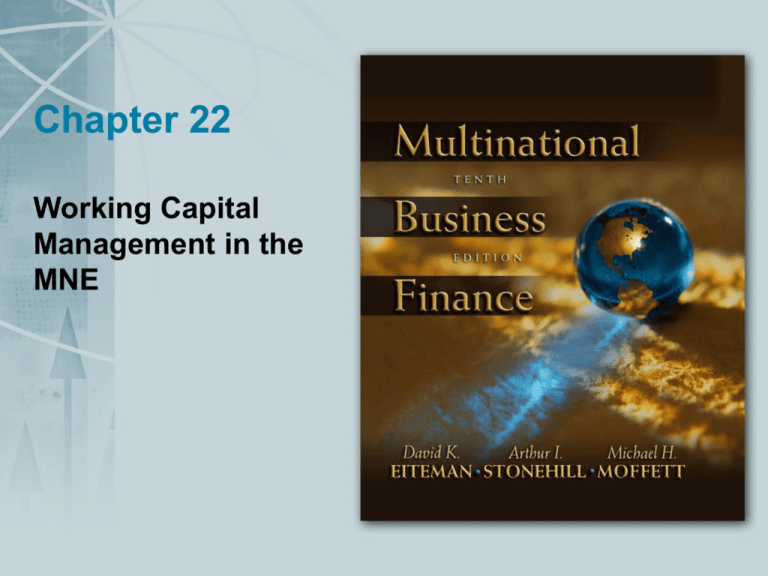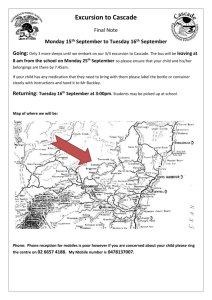
Chapter 22
Working Capital
Management in the
MNE
Working Capital Management
in the MNE
• Working capital management in a multinational
enterprise requires managing current assets (cash
balances, accounts receivable, and inventory) and
current liabilities (accounts payable and short-term
debt) when faced with political, foreign exchange, tax,
and liquidity constraints.
• The overall goal is to reduce funds tied up in working
capital while simultaneously providing sufficient
funding and liquidity for the conduct of global
business.
• Working capital management should enhance return on
assets and return on equity and should also improve
efficiency ratios and other performance measures.
Copyright © 2004 Pearson Addison-Wesley. All rights reserved.
22-2
Working Capital Management
• The operating cycle of a business generates funding
needs, cash inflows and outflows (the cash conversion
cycle) and foreign exchange rate and credit risks.
• The funding needs generated by the operating cycle of
the firm constitute working capital.
• The cash conversion cycle, a subcomponent of the
operating cycle (working capital cycle), is that period
of time extending between cash outflow for purchased
inputs and materials and cash inflow from cash
settlement.
Copyright © 2004 Pearson Addison-Wesley. All rights reserved.
22-3
Working Capital Management
• The operating and cash conversion cycles for Cascade
Mexico is illustrated in the following exhibit.
• This is decomposed into five different periods (each
with business, accounting, and potential cash flow
implications):
– Quotation period
– Input sourcing period
– Inventory period
– Accounts payable period
– Accounts receivable period
Copyright © 2004 Pearson Addison-Wesley. All rights reserved.
22-4
Exhibit 22.1 Operating and Cash Cycles
for Cascade Mexico
Operating Cycle
Accounts
Payable
Period
Input
Sourcing
Period
Quotation
Period
Price
Quote
Cascade
Mexico t
0
Order
Placed
t1
Accounts
Receivable
Period
Inventory
Period
Inputs
Received
t2
Order
Shipped
t3
Payment
Received
t4
t5
Cash
Outflow
Cash
Intflow
Cash
Payment
for Inputs
Copyright © 2004 Pearson Addison-Wesley. All rights reserved.
time
Cash
Settlement
Received
Cash
Conversion Cycle
22-5
Working Capital Management
• If Cascade Mexico’s business continues to
expand, it will continually add to inventories
and accounts payable (A/P) in order to fill
increased sales in the form of accounts
receivable (A/R).
• These components make up net working
capital (NWC):
NWC = (A/R + inventory) – (A/P)
Copyright © 2004 Pearson Addison-Wesley. All rights reserved.
22-6
Exhibit 22.2 Cascade Mexico’s Net Working
Capital Requirements
Net Working Capital (NWC) is the net investment required of the firm
to support on-going sales. NWC components typically grow as the
firm buys inputs, produces product, and sells finished goods.
Cascade Mexico’s Balance Sheet
Assets
Liabilities & Net Worth
Cash
Accounts payable (A/P)
Accounts receivable (A/R)
Short-term debt
Inventory
Current assets
Current liabilities
NWC = ( A/R + Inventory ) - A/P
Note that NWC is not the same as Current assets & Current liabilities.
22-7
Working Capital Management
• The previous exhibit illustrates one of the key managerial
decisions for any subsidiary:
– Should A/P be paid off early, taking discounts offered by suppliers?
– The alternate form of financing for NWC balances is short-term debt
• In our example, Cascade Mexico’s CFO must decide which is the
lower cost (short-term Mexican peso borrowings or the effective
annual interest cost of supplier financing – cost of carry).
• Clearly, there are issues such as access to local currency debt, or
various intra-company financing alternatives that complicate the
decision.
Copyright © 2004 Pearson Addison-Wesley. All rights reserved.
22-8
Working Capital Management
• A common method of benchmarking financial
management practice is to calculate the NWC of
the firm on a “days sales” basis.
• An analysis of this metric in a global context
shows that US firms have a typical days sales of
29, while the European group has a days sales of
75.
• Clearly, European-based (technology firms in this
example) are carrying a significantly higher level
of net working capital in their financial structures.
Copyright © 2004 Pearson Addison-Wesley. All rights reserved.
22-9
Working Capital Management
• The MNE itself poses some unique challenges in the
management of working capital.
• Many multinationals manufacture goods in a few
specific countries and then ship the intermediate
products to other facilities globally for completion and
distribution.
• The payables, receivables, and inventory levels of the
various units are a combination of intra-firm and interfirm.
• The varying business practices observed globally
regarding payment terms – both days and discounts –
create severe mismatches in some cases.
Copyright © 2004 Pearson Addison-Wesley. All rights reserved.
22-10
Exhibit 22.4 Cascade’s Multinational Working
Capital Sequence
Cash inflows to Cascade Mexico arise from local market sales.
These cash flows are used to repay both intra-firm payables
(to Cascade USA) and local suppliers.
Cascade Mexico
Balance Sheet
60 days
A/R
Inventory
Cascade USA
Balance Sheet
Intra-firm:
30 days
30 days
A/P
A/P
A/R
Inventory
A/P
Local-sourcing: 60 days
Mexican Business Practices
United States Business Practices
Payment terms in Mexico are longer than
those typical of the United States. Cascade
Mexico must offer 60-day terms to local
customers to be competitive with other firms
in the local market.
Payment terms used by Cascade USA are
typical of the United States, 30 days. Cascade
USA’s local customers will expect to be paid in
30 days. Cascade USA may consider extending
longer terms to Mexico to reduce the squeeze.
Result: Cascade Mexico is squeezed in terms of cash flow. It receives inflows
in 60 days but must pay Cascade USA in 30 days.
22-11
Working Capital Management
• A firm’s operating cash inflow is derived primarily
from the collection of accounts receivable.
• Multinational accounts receivable are created by two
separate types of transactions:
– Sales to related subsidiaries
– Sales to independent or unrelated buyers
• Management of accounts receivable form independent
customers requires two types of decisions:
– What currency should the transaction be denominated?
– What should be the terms of payment?
Copyright © 2004 Pearson Addison-Wesley. All rights reserved.
22-12
Working Capital Management
• Operations in inflationary, devaluation-prone
economies sometimes force management to modify its
normal approach to inventory management.
• In some cases, management may choose to maintain
inventory and reorder levels far in excess of what
would be called for in an economic order-quantity
model.
• It is important to anticipate:
– Devaluation
– Price freezes
– The implications of various forms of free-trade zones
Copyright © 2004 Pearson Addison-Wesley. All rights reserved.
22-13
International Cash Management
• International cash management is the set of
activities determining the levels of cash
balances held throughout the MNE (cash
management) and the facilitation of its
movement cross-border (settlements and
processing).
• These activities are typically handled by the
international treasury of the MNE.
Copyright © 2004 Pearson Addison-Wesley. All rights reserved.
22-14
International Cash Management
• The level of cash maintained by an individual
subsidiary is determined independent of the working
capital management decisions we have discussed.
• Cash balances, including marketable securities, are
held partly to enable normal day-to-day cash
disbursements and partly to protect against
unanticipated variations from budgeted cash flows.
• These two motives are called the transaction motive
and the precautionary motive.
Copyright © 2004 Pearson Addison-Wesley. All rights reserved.
22-15
International Cash Management
• Cash disbursed for operations is replenished
from two sources:
– Internal working capital turnover
– External sourcing, traditionally short-term
borrowing
• Efficient cash management aims to reduce cash
tied up unnecessarily in the system, without
diminishing profit or increasing risk, so as to
increase the rate of return on invested assets.
Copyright © 2004 Pearson Addison-Wesley. All rights reserved.
22-16
International Cash Management
• All firms, both domestic and international,
engage in some form of the following
fundamental steps:
– Planning
– Collection
– Repositioning
– Disbursement
– Covering cash shortages
– Investing surplus cash
Copyright © 2004 Pearson Addison-Wesley. All rights reserved.
22-17
International Cash Management
• Multinational business increases the complexity of
making payments and settling cash flows between
related and unrelated firms.
• Over time a number of techniques and services have
evolved that simplify and reduce the costs of making
these cross-border payments.
• Four such techniques include:
–
–
–
–
Wire transfers (exhibit 22.5)
Cash pooling
Payment netting (exhibit 22.7)
Electronic fund transfers
Copyright © 2004 Pearson Addison-Wesley. All rights reserved.
22-18
Exhibit 22.5 Average Daily Dollar Amount Handled
by CHIPS (billions of US dollars)
1600
1400
1200
1000
800
600
400
200
0
70
72
74
76
78
80
82
84
86
88
90
92
94
Source: Clearing House Interbank Payment System, http://www.chips.org (April 2002).
96
98
2000
22-19
Exhibit 22.7 Multilateral Matrix Before Netting
(thousands of US dollars)
The Four European Affiliates of Quad Corporation
$4,000
Quad
United Kingdom
Quad de
France
$3,000
$3,000
$5,000
$5,000
$5,000
$6,000
$4,000
$3,000
$2,000
$2,000
Quad
Belgium
$1,000
Deutscheland
Quad
Prior to netting, the four sister affiliates of Quad Corporation have numerous
intra-firm payments between them. Each payment results in transfer charges.
22-20
Financing Working Capital
• All firms need to finance working capital.
• The normal sources of funds for financing short-term working
capital are accounts payable to suppliers and loans against bank
credit lines.
• In some countries, such as the United States, borrowing is done by
the firm issuing notes payable to banks and other creditors.
• In many other countries, short term borrowing is done on an
“overdraft” basis.
• In all cases, permanent working capital requirements, as opposed
to seasonal needs, are at least partially financed with long-term
debt and equity.
Copyright © 2004 Pearson Addison-Wesley. All rights reserved.
22-21
Exhibit 22.9 Multilateral Matrix After Netting
(thousands of US dollars)
The Four European Subsidiaries of Quad Corporation
Quad
United Kingdom
Pays $1,000
Quad
Belgium
Quad de
France
Pays $3,000
Pays $1,000
Deutscheland
Quad
After netting, the four sister subsidiaries of Quad Corporation have only three
net payments to make among themselves to settle all intra-firm obligations
22-22
Financing Working Capital
• Some MNEs have found that their financial resources
and needs are either too large or too sophisticated for
the financial services available in may locations where
they operate.
• One solution to this has been the establishment of an
in-house or internal bank within the firm.
• Such an in-house bank is not a separate corporation;
rather, it is a set of functions performed by the existing
treasury department.
• The following exhibit, illustrates how the in-house
bank of Cascade Pharmaceuticals, Inc., could work.
Copyright © 2004 Pearson Addison-Wesley. All rights reserved.
22-23
Financing Working Capital
• Cascade Mexico sells all its receivables to the in-house
bank as they arise, reducing some of the domestic working
capital needs.
• Additional working capital needs are supplied by the inhouse bank directly to Cascade Mexico.
• Because the in-house bank is part of the same company,
the interest rates it charges may be significantly lower than
what Cascade Mexico could obtain on its own.
• In addition to providing financing benefits, in-house banks
allow for more effective currency risk management.
Copyright © 2004 Pearson Addison-Wesley. All rights reserved.
22-24
Exhibit 22.10 Cascade’s In-House Bank
Cascade Europe deposits excess cash balances
with the in-house bank.
Cash flow
Cascade’s
In-House
Bank
Cascade Europe
Cascade’s in-house bank
reallocates cash and capital
within the MNE network.
Cascade Mexico
Cash flow
Cascade Mexico sells its receivables to the in-house bank,
receiving cash and receiving working capital financing.
22-25
Financing Working Capital
• MNEs depend on their commercial banks to
handle most of the trade financing needs, such
as letters of credit, and to provide advice on
government support, country risk assessment,
introductions to foreign firms and banks, and
general financing availability.
• The main points of bank contacts are
correspondent banks, representative offices,
branch banks, subsidiaries, and affiliates.
Copyright © 2004 Pearson Addison-Wesley. All rights reserved.
22-26









